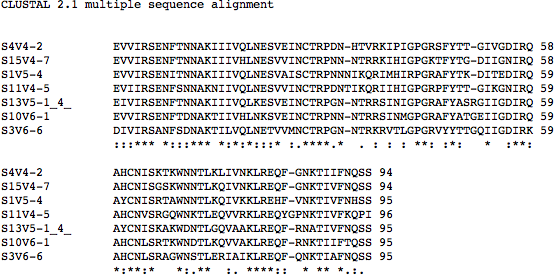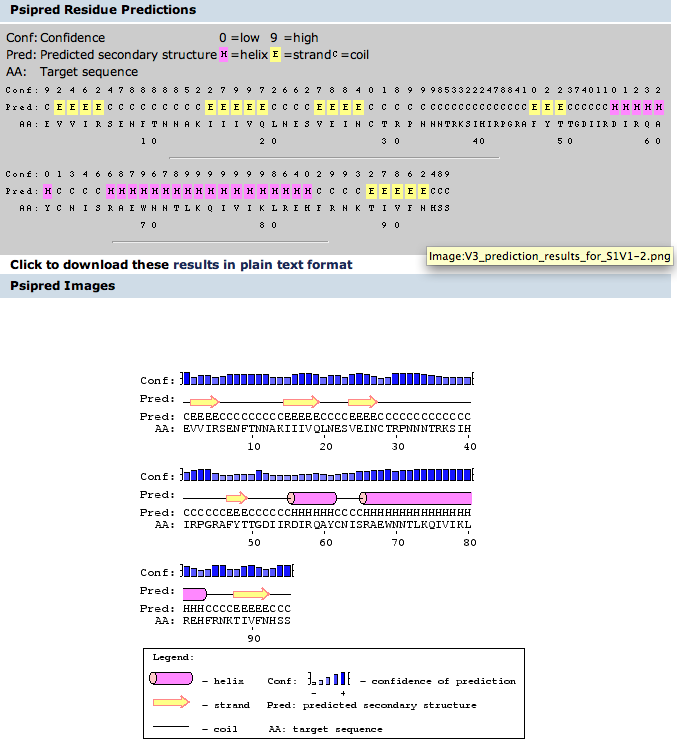Alex A. Cardenas Week 9: Difference between revisions
From OpenWetWare
Jump to navigationJump to search
No edit summary |
No edit summary |
||
| Line 41: | Line 41: | ||
#Using StarBiochem to work with gp120 peptide and the ternary complex structures. | #Using StarBiochem to work with gp120 peptide and the ternary complex structures. | ||
#*Locate the N-terminus and C-terminus of each (poly)peptide structure. | #*Locate the N-terminus and C-terminus of each (poly)peptide structure. | ||
#*Locate all the secondary structure elements (found below. purple=helices; yellow=sheets; blue=coils. Do these match the predictions you made above? | #*Locate all the secondary structure elements (found below. purple=helices; yellow=sheets; blue=coils. Do these match the predictions you made above? Yes for all of the helices --> they match. As for the sheets and coils, some of them match while others do not. | ||
#**Secondary Structure 1GC1 - [[Image:Secondary 1GC1.png]] | #**Secondary Structure 1GC1 - [[Image:Secondary 1GC1.png]] | ||
#**Secondary Structure 1F58 - [[Image:Secondary 1F58.png]] | #**Secondary Structure 1F58 - [[Image:Secondary 1F58.png]] | ||
Revision as of 16:06, 26 October 2011
HIV Structure Project
- Working with Robert and Zeb.
- V3 loop conformation is the main area of study and comparing these regions with those who developed AIDs and those who did not. We will investigate these different conformations and how they compare with the given numbers such as CD4 T cell count, ratios, etc.
- Rapid progressors sequences will be compared to moderate and non progressors. Subjects of interest are 1, 3, 4, 10, 11, and 15. Moderate progessors of interest 6 and non-progressor 13.
- The following visits for each subject will be studied. We will be comparing pre and post AIDs (in relation to the # of CD4 T cell count). The conformational changes of the V3 loop will be looked at when the subjects have the highest CD4 T cell count and the lowest CD4 T cell count (except for the subjects 6 and 13).
- Subject 1 - visit 1 and 3.
- Subject 3 - visit 1 and 5.
- Subject 4 - visit 1 and 4.
- Subject 10 - visit 1 and 5.
- Subject 11 - visit 1 and 4.
- Subject 15 - visit 1 and 4.
- Subject 6 (moderate progressor) - visit 9.
- Subject 13 (non-progressor)- visit 5.
HIV Structure Project Exercises
- Converting DNA sequences into protein sequences.
- The following amino acid sequences can be found [here].
- This would be done using www.ncbi.nlm.nih.gov/gorf/gorf.html --> and then entering in each of the DNA sequences but the sequence data in BEDROCK already gives us the amino acid sequences.
- Perform a multiple sequence alignment on the protein sequences.
- This was doing through ClustalW (www.ebi.ac.uk/clustalw.). The amino acid sequences were pasted into the ClustalW sequence box and the results were made.
- Subject 1 multiple sequence alignment:

- Subject 3 multiple sequence alignment:

- Subject 4 multiple sequence alignment:

- Subject 10 multiple sequence alignment:

- Subject 11 multiple sequence alignment:

- Subject 15 multiple sequence alignment:

- Subject 6 multiple sequence alignment - ran with last visits of subjects above:

- Subject 13 multiple sequence alignment - ran with all subjects last visits not including subject 6:

- There are fewer differences when looking at the protein sequences when compared to the DNA sequences.
- This can be accounted for because different DNA sequence codons can can still code for the same amino acid.
- Which of the procedures from Chapter 6 that you ran on the entire gp120 sequence are applicable to the V3 fragment you are working with now?
- How are they applicable?
- Chapter 11 contains procedures to use for working with protein 3D structures. Find the section on "Predicting the Secondary Structure of a Protein Sequence" and perform this on both the entire gp120 sequence and on the V3 fragment that we are now working with. You will compare the predictions with the actual structures.
- Download the structure files for the papers we read in journal club from the NCBI Structure Database.
- Using StarBiochem to work with gp120 peptide and the ternary complex structures.
- Locate the N-terminus and C-terminus of each (poly)peptide structure.
- Locate all the secondary structure elements (found below. purple=helices; yellow=sheets; blue=coils. Do these match the predictions you made above? Yes for all of the helices --> they match. As for the sheets and coils, some of them match while others do not.
- Locate the V3 region and figure out which sequences from your alignment are present in the structures and which sequences are absent.
Links
- Alex A. Cardenas
- Week 9 Assignment
- Alex A. Cardenas Week 2
- Alex A. Cardenas Week 3
- Alex A. Cardenas Week 4
- Alex A. Cardenas Week 5
- Alex A. Cardenas Week 6
- Alex A. Cardenas Week 7
- Alex A. Cardenas Week 8
- Alex A. Cardenas Week 9
- Alex A. Cardenas Week 10
- Alex A. Cardenas Week 11
- BIOL368/F11:Class Journal Week 1
- BIOL368/F11:Class Journal Week 2
- BIOL368/F11:Class Journal Week 3
- BIOL368/F11:Class Journal Week 5
- BIOL368/F11:Class Journal Week 6
- BIOL368/F11:Class Journal Week 7
- BIOL368/F11:Class Journal Week 8
- BIOL368/F11:Class Journal Week 9
- BIOL368/F11:Class Journal Week 10








